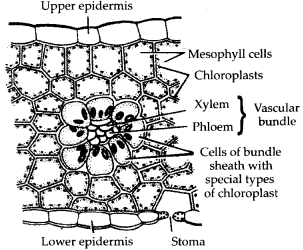Photorespiration rates are increased by:
I:
lowered availability of carbon dioxide
II:
increased availability of oxygen
III:
increased temperature
1.
Only I and II
2.
Only I and III
3.
Only II and III
4.
I, II and III

To unlock all the explanations of 38 chapters you need to be enrolled in MasterClass Course.

To unlock all the explanations of 38 chapters you need to be enrolled in MasterClass Course.
The ATP synthase complexes in a plant cell are located:
| I: | in the thylakoid membrane |
| II: | in the plasma membrane |
| III: | in the inner mitochondrial membrane |
| 1. | I and II only | 2. | I and III only |
| 3. | II and III only | 4. | I, II and III |

To unlock all the explanations of 38 chapters you need to be enrolled in MasterClass Course.

To unlock all the explanations of 38 chapters you need to be enrolled in MasterClass Course.
A possible purpose of photorespiration may be:
| 1. | assimilation of nitrate from the soil |
| 2. | translocation of carbohydrates |
| 3. | enhanced PGR efficiency |
| 4. | differentiation of plant cells |
The following diagram shows bundle sheath cells with “special” types of chloroplasts. What is special about them?

| 1. | They are larger than normal size |
| 2. | They are agranal |
| 3. | They are dimorphic |
| 4. | Calvin cycle cannot take place in them |
In chloroplasts, protons are actively pumped from
| 1. | the intermembrane space to the matrix. |
| 2. | the matrix to the stroma. |
| 3. | the stroma to the thylakoid space. |
| 4. | the thylakoid space to the intermembrane space. |

To unlock all the explanations of 38 chapters you need to be enrolled in MasterClass Course.

To unlock all the explanations of 38 chapters you need to be enrolled in MasterClass Course.
The following diagram shows the photosynthetic carbon cycle. A and B can respectively be:
| 1. | Pyruvate; malate or aspartate |
| 2. | Phoshoglycerate; fumarate or aspartate |
| 3. | Phosphoenol pyruvate; malate or aspartate |
| 4. | Phosphoenol pyruvate; fumarate or aspartate |

To unlock all the explanations of 38 chapters you need to be enrolled in MasterClass Course.

To unlock all the explanations of 38 chapters you need to be enrolled in MasterClass Course.
The relationship between photosynthesis and respiration can be best described as:
| 1. | Photosynthesis and respiration are reversal of each other in biochemical pathways. |
| 2. | Photosynthesis stores energy in complex organic molecules, while respiration releases it. |
| 3. | Respiration occurs only in animals and photosynthesis occurs only in plants. |
| 4. | Respiration results in formation of ATP but photosynthesis can only use them. |
Identify the incorrect statement regarding the enzyme PEP carboxylase:
| 1. | PEP carboxylase has a lower Km for bicarbonate ions, hence, higher affinity — than RuBisCO. |
| 2. | O2 is a very poor substrate for this enzyme. |
| 3. | It plays an important role in C4 cycle but not in CAM plants. |
| 4. | PEP carboxylase is also significant in non-photosynthetic metabolic pathways. |

To unlock all the explanations of 38 chapters you need to be enrolled in MasterClass Course.

To unlock all the explanations of 38 chapters you need to be enrolled in MasterClass Course.
What can occur during both photosynthesis and respiration?
I: The reduction of oxygen that forms water.
II: Formation of ATP by chemiosmosis
| 1. | Only I | 2. | Only II |
| 3. | Both I and II | 4. | None |
Carbon dioxide splits to form oxygen during:
1. photosynthesis.
2. respiration.
3. photorespiration.
4.None.

To unlock all the explanations of 38 chapters you need to be enrolled in MasterClass Course.

To unlock all the explanations of 38 chapters you need to be enrolled in MasterClass Course.








